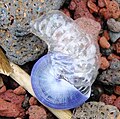Portuguese man o' war
(Redirected from Portuguese man-of-war dermatitis)
Portuguese man o' war
The Portuguese man o' war, also known as Physalia physalis, is a marine creature that belongs to the phylum Cnidaria and the class Hydrozoa. Despite its name, it is not a true jellyfish but a siphonophore, which is a colonial organism made up of specialized individual animals called zooids.
Description
The Portuguese man o' war is characterized by its distinctive appearance. It consists of a gas-filled bladder, or pneumatophore, which acts as a float and allows it to stay at the ocean's surface. The pneumatophore can reach lengths of up to 30 centimeters and has a blue or purple color. Below the float, long tentacles extend, which can measure up to 10 meters in length. These tentacles are equipped with venomous cells called nematocysts, which are used for capturing prey and defense.
Habitat and Distribution
Portuguese man o' wars are commonly found in warm oceanic waters, particularly in the Atlantic, Indian, and Pacific Oceans. They are known to inhabit the surface of the water, where they drift with the currents. Due to their floating nature, they are often seen in large groups, known as colonies or fleets.
Behavior
The Portuguese man o' war is a carnivorous predator that feeds on small fish and plankton. Its tentacles are equipped with venomous nematocysts, which are used to immobilize and capture prey. When a prey item comes into contact with the tentacles, the nematocysts release toxins that paralyze the prey, allowing the Portuguese man o' war to consume it.
Human Interaction
Encounters with Portuguese man o' wars can be dangerous for humans. While their venom is rarely lethal, it can cause severe pain, skin irritation, and allergic reactions. It is important to avoid touching or swimming near these creatures to prevent stings. If stung, immediate medical attention should be sought.
Conservation Status
The Portuguese man o' war is not currently listed as an endangered species. However, its populations can be affected by pollution, climate change, and overfishing, which can disrupt their habitats and food sources. Monitoring and conservation efforts are important to ensure the long-term survival of this species.
See Also
References
Transform your life with W8MD's budget GLP-1 injections from $125.
W8MD offers a medical weight loss program to lose weight in Philadelphia. Our physician-supervised medical weight loss provides:
- Most insurances accepted or discounted self-pay rates. We will obtain insurance prior authorizations if needed.
- Generic GLP1 weight loss injections from $125 for the starting dose.
- Also offer prescription weight loss medications including Phentermine, Qsymia, Diethylpropion, Contrave etc.
NYC weight loss doctor appointments
Start your NYC weight loss journey today at our NYC medical weight loss and Philadelphia medical weight loss clinics.
- Call 718-946-5500 to lose weight in NYC or for medical weight loss in Philadelphia 215-676-2334.
- Tags:NYC medical weight loss, Philadelphia lose weight Zepbound NYC, Budget GLP1 weight loss injections, Wegovy Philadelphia, Wegovy NYC, Philadelphia medical weight loss, Brookly weight loss and Wegovy NYC
|
WikiMD's Wellness Encyclopedia |
| Let Food Be Thy Medicine Medicine Thy Food - Hippocrates |
Medical Disclaimer: WikiMD is not a substitute for professional medical advice. The information on WikiMD is provided as an information resource only, may be incorrect, outdated or misleading, and is not to be used or relied on for any diagnostic or treatment purposes. Please consult your health care provider before making any healthcare decisions or for guidance about a specific medical condition. WikiMD expressly disclaims responsibility, and shall have no liability, for any damages, loss, injury, or liability whatsoever suffered as a result of your reliance on the information contained in this site. By visiting this site you agree to the foregoing terms and conditions, which may from time to time be changed or supplemented by WikiMD. If you do not agree to the foregoing terms and conditions, you should not enter or use this site. See full disclaimer.
Credits:Most images are courtesy of Wikimedia commons, and templates, categories Wikipedia, licensed under CC BY SA or similar.
Translate this page: - East Asian
中文,
日本,
한국어,
South Asian
हिन्दी,
தமிழ்,
తెలుగు,
Urdu,
ಕನ್ನಡ,
Southeast Asian
Indonesian,
Vietnamese,
Thai,
မြန်မာဘာသာ,
বাংলা
European
español,
Deutsch,
français,
Greek,
português do Brasil,
polski,
română,
русский,
Nederlands,
norsk,
svenska,
suomi,
Italian
Middle Eastern & African
عربى,
Turkish,
Persian,
Hebrew,
Afrikaans,
isiZulu,
Kiswahili,
Other
Bulgarian,
Hungarian,
Czech,
Swedish,
മലയാളം,
मराठी,
ਪੰਜਾਬੀ,
ગુજરાતી,
Portuguese,
Ukrainian
Contributors: Prab R. Tumpati, MD










